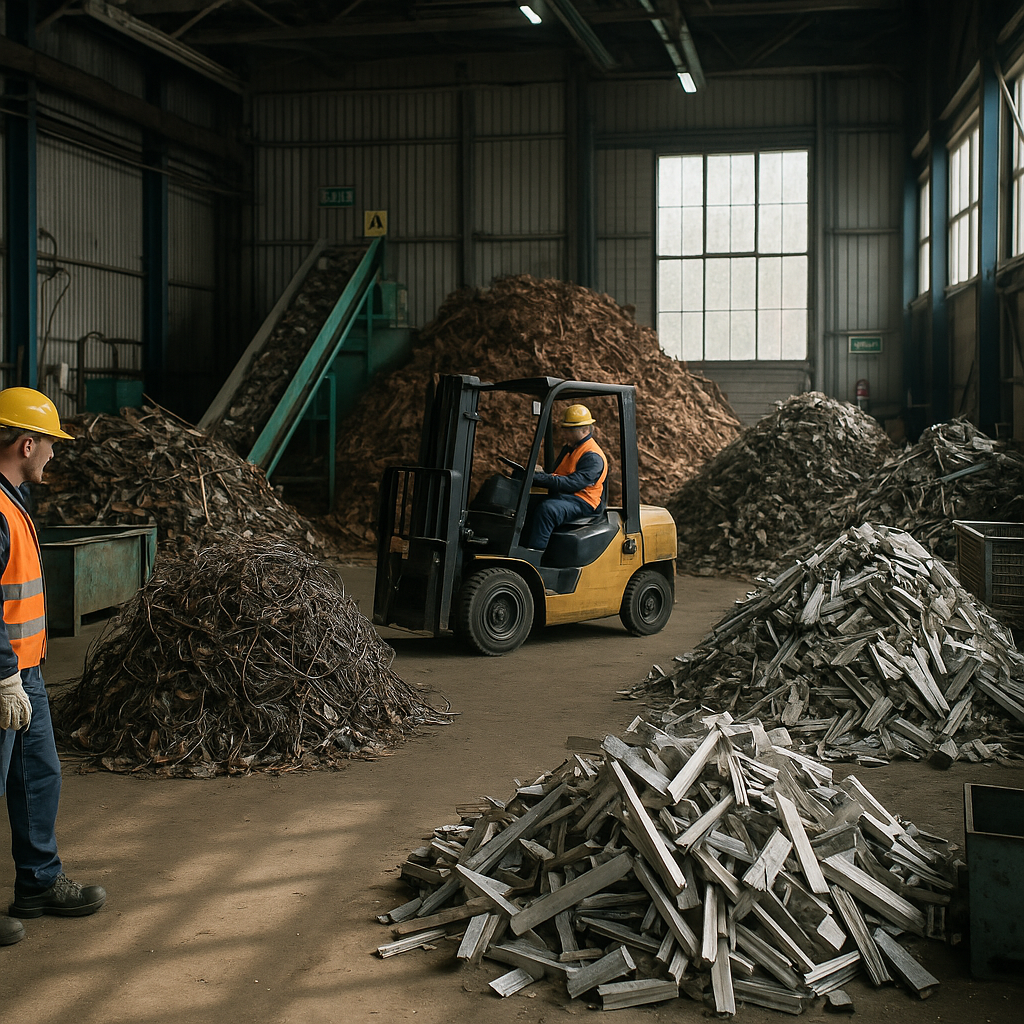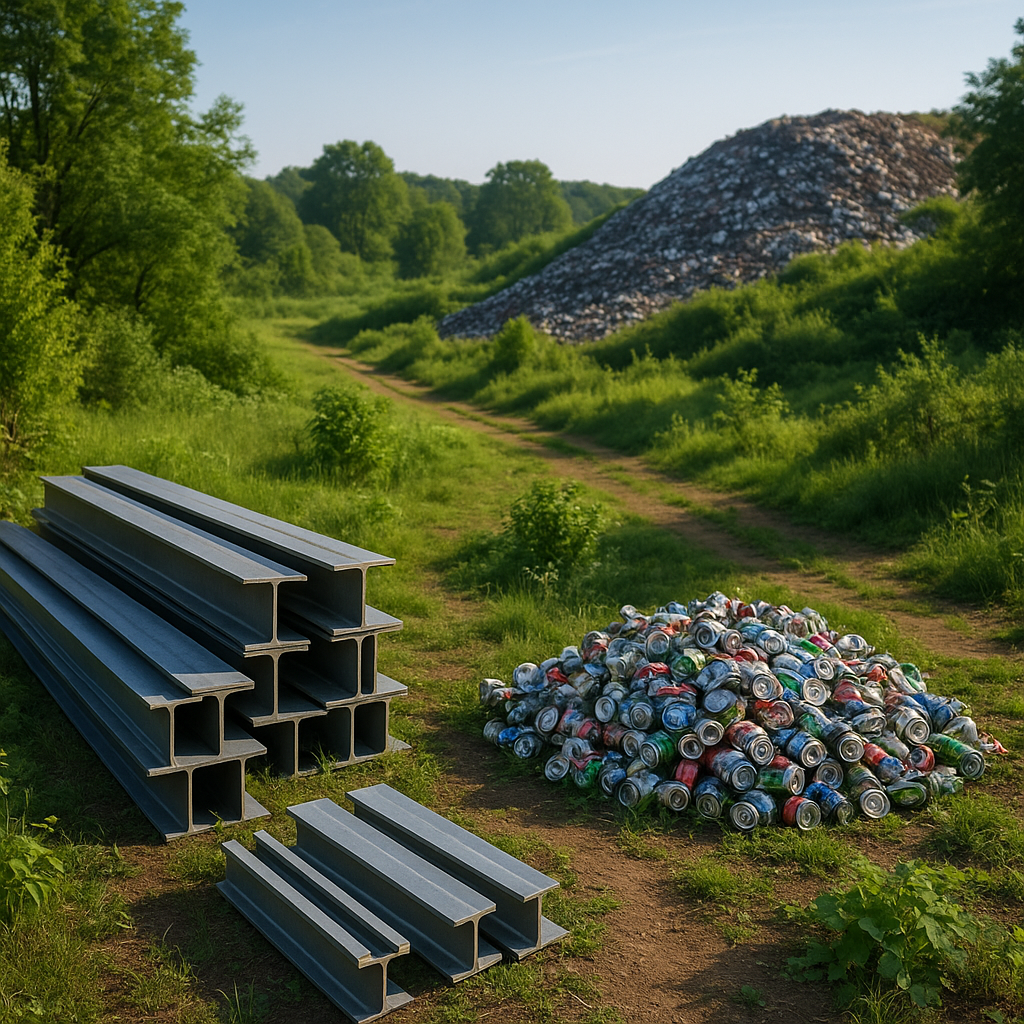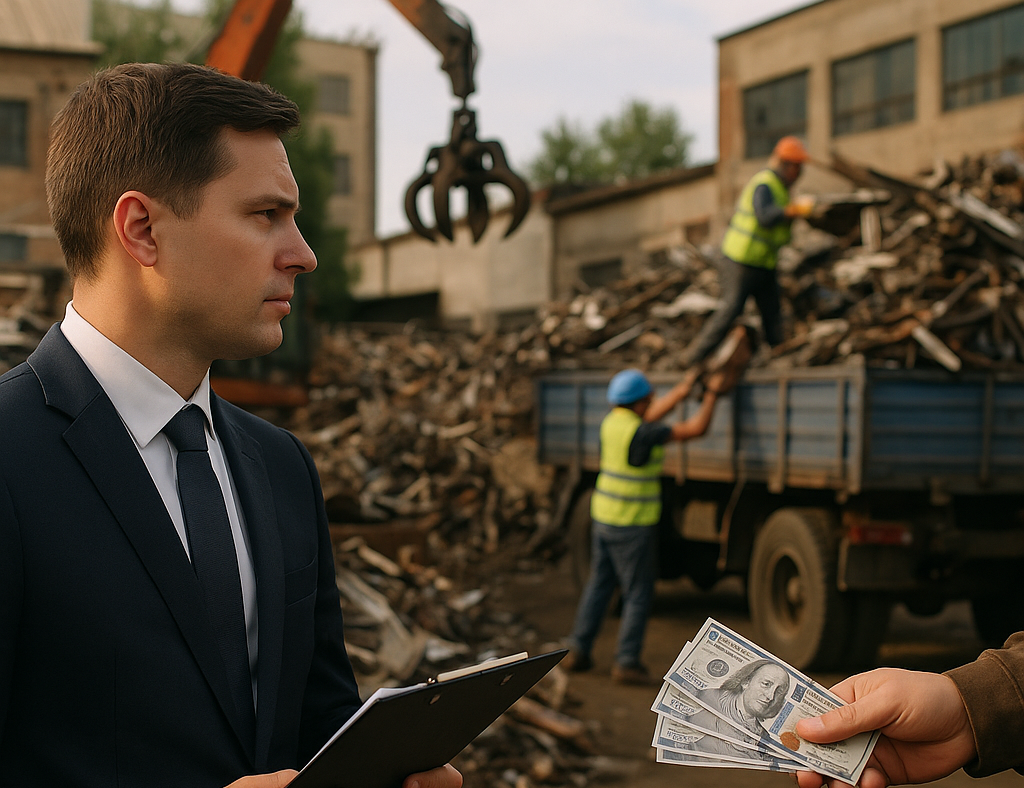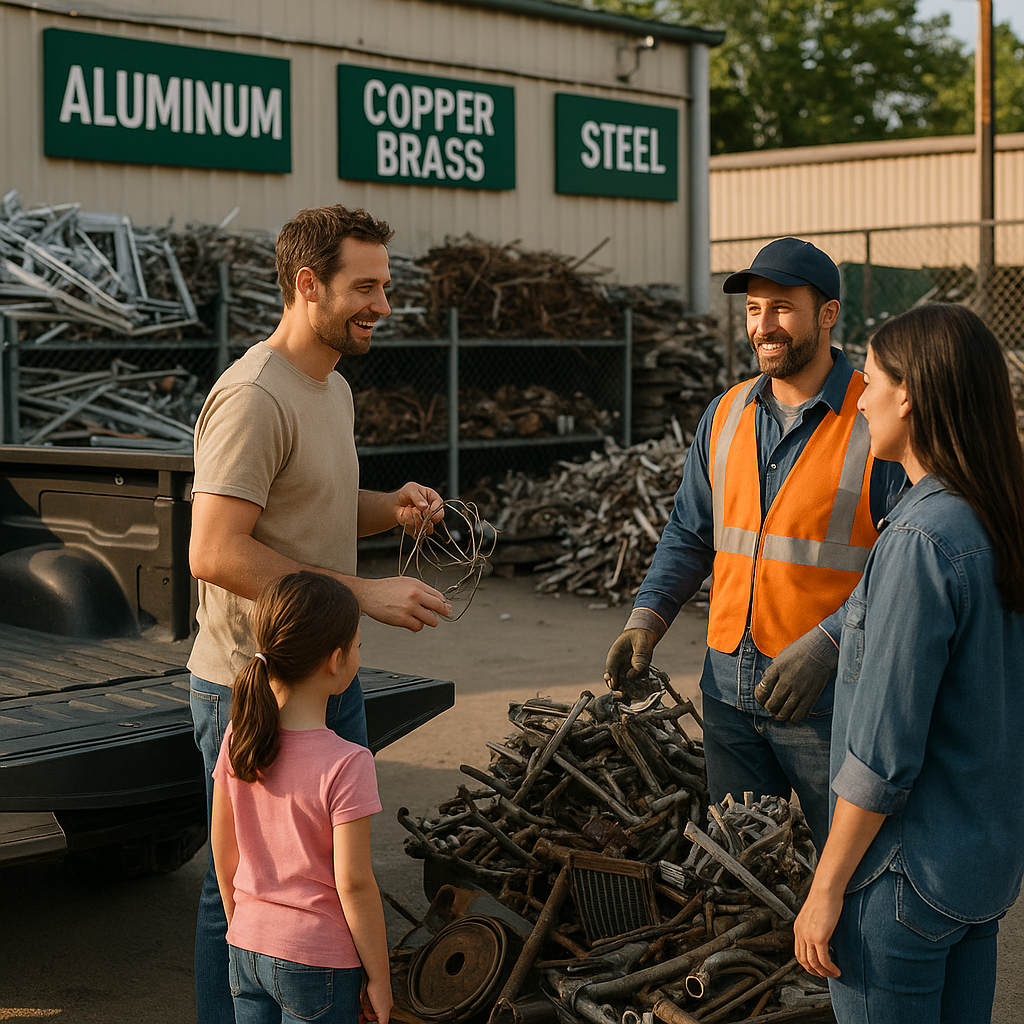5901 Botham Jean Blvd, Dallas, TX 75215
Circular Economy for Scrap Metal: A Quick Guide for Beginners
September 21, 2025The circular economy for scrap metal marks a significant transformation in how we view and manage metal resources. The core objective is to keep valuable metals in continuous use through recycling and reuse, rather than discarding them in landfills. Unlike the traditional ‘take-make-dispose’ model that has dominated industrial practices for centuries, the circular economy creates a closed-loop system where today’s scrap metal becomes tomorrow’s new product.
When metal products reach the end of their useful life, they don’t become waste but transform into valuable raw materials, ready to start a new lifecycle. This closed-loop system ensures that metals maintain their utility indefinitely. Most metals can be recycled repeatedly without degrading their inherent properties, making them ideal for a circular approach.
The concept extends beyond simple recycling. A truly circular economy for scrap metal redesigns the entire metal lifecycle—from extraction and production to consumption and recovery. It aims to minimize waste at every stage while maximizing the value extracted from each piece of metal. This method supports environmental sustainability by reducing the need to mine virgin resources, decreasing energy consumption, and limiting the environmental impact of metal production.
How Does Scrap Metal Recycling Support the Circular Economy?

Scrap metal recycling is a crucial aspect of the circular economy, creating a sustainable loop that conserves valuable materials without depleting finite resources. This process transforms what was once considered waste into valuable raw materials, establishing a renewable cycle with benefits for both the environment and the economy.
The circular economy model moves away from the traditional linear ‘take-make-dispose’ approach, which depletes resources. It creates a closed-loop system where materials maintain their value and utility through continuous recycling and reuse. Metal recycling epitomizes this concept, as metals can be recycled repeatedly without significant degradation in their properties.
Energy Conservation: A Powerful Impact
One of the key benefits of scrap metal recycling is the significant reduction in energy consumption. Manufacturing metals from recycled materials requires much less energy than producing them from virgin ores, leading to environmental benefits and cost savings.
Recycling aluminum saves up to 95% of the energy needed for primary production from bauxite ore. Steel recycling conserves about 60-75% of the energy required for production from iron ore. Copper recycling reduces energy usage by approximately 85% compared to mining new copper.
The Institute of Scrap Recycling Industries reports that metal recycling annually saves enough energy to power around 20 million households for a year. These energy savings alleviate pressure on power grids and decrease reliance on fossil fuels.
Emissions Reduction: Fighting Climate Change
The energy conservation achieved through metal recycling directly contributes to significant reductions in greenhouse gas emissions. According to the Environmental Protection Agency, recycling one ton of steel prevents approximately 1,000 to 1,500 pounds of carbon dioxide from entering the atmosphere.
Studies show that recycling steel and aluminum can reduce greenhouse gas emissions by 86% and 95%, respectively. The EPA reports that metal recycling reduces greenhouse gas emissions by 29 million tons of carbon dioxide annually, equivalent to removing 6.3 million cars from roads.
Every piece of scrap metal recycled contributes to lowering our collective carbon footprint and combating climate change.
Resource Preservation: Protecting Natural Landscapes
Metal extraction through mining causes severe environmental damage, including habitat destruction, soil erosion, and chemical contamination. Recycling one ton of steel conserves around 2,500 pounds of iron ore, 1,400 pounds of coal, and 120 pounds of limestone.
Water resource conservation is another crucial benefit. Metal recycling can significantly reduce water consumption. Recycling copper, for instance, can decrease water use by as much as 90% compared to primary production methods.
By reducing the need for mining operations, recycling helps protect natural habitats, prevent soil erosion, and maintain biodiversity in areas that would otherwise be disrupted by extraction activities.
Creating a Closed-Loop System
The ultimate goal of scrap metal recycling in the circular economy is to create a genuinely closed-loop system. In this model, metals recovered from recycled scrap are continuously reintroduced into new metal products, creating a sustainable cycle where materials remain in productive use indefinitely.
This closed-loop approach reduces the need for new resource extraction and minimizes waste sent to landfills. Metals in landfills take hundreds or even thousands of years to break down naturally, and many contain harmful chemicals that can leach into soil and groundwater.
By keeping metals in circulation through recycling, we prevent these environmental hazards while preserving valuable landfill space. Each ton of metal recycled saves cubic yards of landfill space for waste that cannot be recycled.
The circular economy model powered by metal recycling shows that environmental responsibility and economic prosperity can work hand in hand, creating a more sustainable future for generations to come.
What Are the Environmental Benefits of Scrap Metal in a Circular Economy?

Incorporating scrap metal into a circular economy has significant environmental benefits beyond mere waste reduction. Recycling metals instead of mining and processing virgin ore leads to immediate, substantial environmental improvements across various ecosystems.
Recycling scrap metal significantly reduces pollution levels. The process cuts air pollution by up to 80% compared to primary metal production, markedly improving air quality in nearby communities. Water pollution decreases by 76%, safeguarding aquatic ecosystems from toxic runoff that could otherwise contaminate rivers, lakes, and groundwater. Water consumption also drops by approximately 40%, conserving this vital resource, especially crucial as freshwater scarcity affects billions worldwide.
These statistics manifest as cleaner air in industrial areas, healthier waterways for wildlife, and improved water security in regions facing shortages. The reduction in air pollutants is akin to removing millions of vehicles from roads annually.
Reducing the need for extractive mining is another visible benefit. Metal ore extraction causes massive land disruption, often completely destroying natural habitats. Open-pit mines, spanning thousands of acres, can transform lush environments into barren sites. Recycling existing metals minimizes the expansion of these destructive operations and preserves biodiversity hotspots otherwise at risk due to resource extraction.
The resource conservation figures are equally noteworthy. Recycling a ton of steel saves approximately 2,500 pounds of iron ore, 1,400 pounds of coal, and 120 pounds of limestone, resources that remain untouched and help maintain ecosystem balance and function.
Another crucial benefit is the reduction of carbon emissions. Recycling metals requires significantly less energy than extracting and processing virgin materials. For instance, steel production from recycled materials generates 58% less carbon dioxide and uses 74% less energy compared to production from raw materials. For aluminum, recycling requires just 5% of the energy needed for primary production, illustrating an even more dramatic difference.
This climate impact is particularly significant, given the metal industry’s carbon footprint, which accounts for roughly 8% of global energy-related CO2 emissions annually. By shifting to a circular model, where scrap metal becomes the primary input instead of virgin ore, the industry can markedly reduce its climate change contribution.
Soil quality also benefits from increased metal recycling. Mining operations often contaminate surrounding soil with heavy metals and processing chemicals, rendering it unsuitable for agriculture or natural regrowth. Recycling keeps these contaminants within the recycling stream, preventing their introduction into new environments.
Beyond immediate environmental benefits, scrap metal recycling creates ripple effects throughout the supply chain. Reduced transportation needs for heavy ores mean fewer emissions from shipping and freight. Less processing of raw materials results in reduced chemical use in extraction and refinement, amplifying the environmental advantages of embracing scrap metal within a circular economy.
As the global shift towards circular economic models grows, scrap metal recycling becomes increasingly central to sustainable development. By maintaining metals in circulation and minimizing new resource extraction, we protect ecosystems, reduce pollution, conserve water, and contribute to climate stability—benefits extending far beyond recycling facilities.
What Economic Advantages Does the Scrap Metal Circular Economy Offer?

The scrap metal recycling industry is a significant economic force in the United States, generating more than $105 billion in annual economic activity. This places the industry alongside major sectors like cosmetics and aircraft engines, transforming what many view as mere waste into a powerful manufacturing driver with extensive financial benefits.
Job creation is one of the most important economic advantages of scrap metal recycling, supporting approximately 500,000 jobs nationwide, including 150,000 direct positions in processing facilities. These jobs offer above-average wages, with recycling facility workers earning around $77,000 annually in wages and benefits. The employment impact extends beyond recycling centers to areas like transportation, equipment manufacturing, and various support services.
Tax contributions from the scrap metal circular economy provide essential revenue for government services at all levels. The industry generates about $10.3 billion in tax revenues annually, with $4.4 billion directed to state and local governments and $6.8 billion to the federal government. These funds support critical public infrastructure, schools, emergency services, and community development initiatives that benefit citizens directly.
Manufacturing industries gain substantial cost advantages through recycled materials. Manufacturers using recycled metals can reduce production costs by up to 33% compared to using virgin materials. For example, producing aluminum from recycled sources requires only 5% of the energy needed for extraction from bauxite ore. These energy and cost savings make American manufacturers more globally competitive while keeping consumer prices more affordable.
The export market adds another dimension to the economic benefits. Recycled scrap commodities are among America’s largest exports by value, with materials sold to over 160 countries worldwide. These exports generate nearly $24 billion in sales annually, accounting for about 39% of the industry’s economic activity and creating approximately 125,000 jobs.
Supply chain resilience improves significantly through domestic scrap metal recycling. By providing a reliable secondary source of raw materials, the industry helps manufacturers avoid price volatility and supply disruptions in primary metal markets. This stability becomes increasingly valuable as global supply chains face challenges and uncertainty.
Local economies benefit directly from scrap metal operations within their communities. Both small-scale collectors and larger recycling facilities create business activity, employment opportunities, and tax revenue that strengthen local economic foundations. The industry’s distributed nature ensures these benefits reach communities of all sizes across the country.
The shift to green technologies creates expanding market opportunities for the scrap metal industry. Rising demand for metals in electric vehicles, renewable energy infrastructure, and energy-efficient construction drives growth throughout the recycling sector. For instance, the global market for aluminum in sustainable technologies could potentially source 50% of its needs from recycled materials.
By reducing dependence on imported raw materials, the scrap metal circular economy strengthens national economic security. This self-sufficiency is increasingly important as countries worldwide compete for limited resources. The industry’s ability to extract value from what would otherwise be waste demonstrates how environmental sustainability and economic prosperity can effectively work together.
How Can Individuals and Businesses Support the Scrap Metal Circular Economy?
Individual Actions That Make a Difference
Households generate metal waste that can be redirected from landfills. Start by identifying and separating metal items in your home. Aluminum cans, steel food containers, and small metal objects can all be recycled instead of trashed.
Conduct a simple household metal audit. Search your home for unused appliances, tools, or electronics containing valuable metals. Don’t let these items gather dust; take them to local recycling centers for material recovery and reuse.
When shopping, choose products made from recycled metals. These typically require up to 95% less energy to produce than those using virgin materials. Your purchasing decisions create demand that supports the recycling ecosystem.
- Clean metal items before recycling to prevent contamination
- Check with local recyclers about accepted metals
- Look for products with high recycled metal content
- Repair metal items whenever possible instead of replacing them
Effective Business Recycling Strategies
Businesses generate ample amounts of scrap metal through operations, equipment upgrades, and facility maintenance. A comprehensive metal recycling program starts by conducting a waste audit to identify recyclable materials. Train employees on proper sorting techniques to maximize the value of collected materials.
Partner with reputable scrap collectors who provide suitable containers and regular pickup schedules. These partnerships often generate revenue from valuable metals like copper, aluminum, and stainless steel while supporting sustainability goals.
Supply chain sustainability offers more opportunities. Collaborate with suppliers to reduce metal packaging waste or implement take-back programs for end-of-life products. Some businesses succeed by joining industry coalitions focused on metal recycling to share best practices.
- Create designated collection points throughout your facility
- Include recycling performance in departmental metrics
- Document materials diverted from landfills for sustainability reporting
- Consider closed-loop systems where your scrap becomes new inputs
Community Initiatives That Strengthen Circular Systems
Local recycling drives enable both individuals and businesses to engage in the scrap metal circular economy. Schools, community centers, and religious organizations often host collection events that accept everything from aluminum cans to obsolete electronics, raising awareness and making recycling more accessible.
Educational workshops teach proper recycling techniques and highlight the environmental benefits of metal recovery. Businesses can sponsor these events or offer expertise on specific materials. Collaboration between public and private sectors enhances community recycling infrastructure.
Strategic partnerships between businesses and environmental organizations can enhance recycling efforts, offering expertise and guidance on effective practices. Environmental organizations help maximize the impact of recycling programs through proven strategies.
- Volunteer at or organize community collection events
- Support local policies that strengthen recycling infrastructure
- Share information about proper metal recycling through social networks
- Participate in neighborhood cleanup events to recover metal waste
Economic Benefits of Participation
Both individuals and businesses can gain financial benefits from supporting the scrap metal circular economy. Many recycling centers pay for metals like copper, brass, aluminum, and steel. Prices fluctuate with market conditions, but consistent recycling can generate supplemental income.
For businesses, comprehensive recycling programs can significantly reduce waste disposal costs. As landfill tipping fees rise, diverting metal from waste streams results in immediate savings. Some companies find that selling scrap metal offsets their entire waste management costs.
Tax incentives may also be available for businesses investing in recycling equipment or sustainable waste management practices. These incentives, combined with potential revenue from scrap sales, provide compelling economic reasons to support the circular economy.
The collective impact is significant. The scrap metal recycling industry contributes over $105 billion in economic activity annually in the United States, supporting about 500,000 jobs across the nation.
| Stakeholder | Benefit Type | Details |
|---|---|---|
| Manufacturers | Cost Savings | Up to 33% reduction in production costs |
| Recycling Industry | Economic Activity | Generates over $105 billion annually |
| Job Creation | Employment | Supports approximately 500,000 jobs |
| Governments | Tax Revenue | $10.3 billion in annual tax revenues |
| Environment | Greenhouse Gas Emissions Reduction | Reduces emissions by 86% for steel, 95% for aluminum |
Conclusion: The Future of Scrap Metal in the Circular Economy

The scrap metal circular economy represents a transformative approach to resource management. This sustainable model balances environmental stewardship with economic prosperity through innovative recycling practices. Metals recycling significantly reduces energy consumption, with savings of up to 80% compared to producing new materials. These efficiencies lead to substantial reductions in greenhouse gas emissions, with recycled metals cutting carbon emissions by up to 58%.
The benefits extend beyond environmental impact. Scrap metal recycling creates valuable jobs in collection, processing, and manufacturing while reducing reliance on raw material extraction. Advanced technologies like AI-driven sorting systems and blockchain traceability are improving the industry, making recycling more efficient and transparent. As the demand for sustainable materials grows across the construction, renewable energy, and transportation sectors, recycled metals will be increasingly vital in building a resilient, low-carbon future. For your recycling needs, contact Okon Recycling at 214-717-4083.
